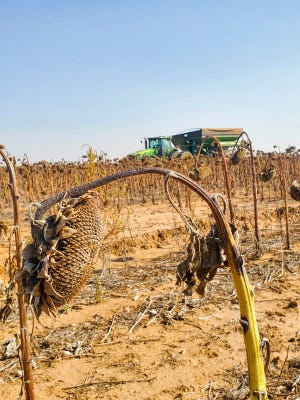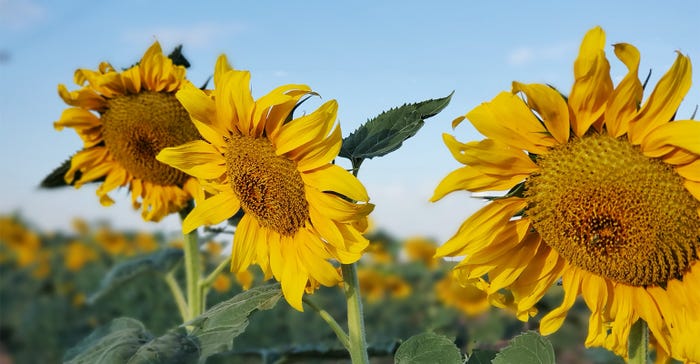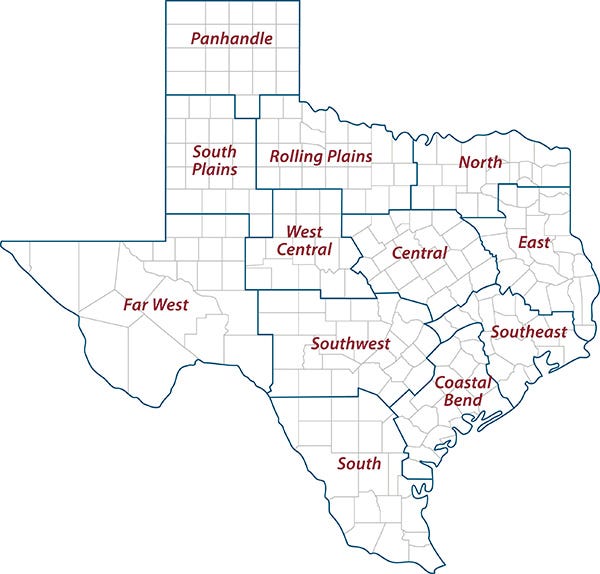
Sunflowers and sesame experienced a decent 2022 with good market prices, but interest in alternative crops dipped slightly as more producers chose to plant major commodities, said Texas A&M AgriLife Extension Service Agronomist Calvin Trostle, Lubbock.
High commodity prices for crops like corn, sorghum and cotton and historically high input costs led to fewer acres of alternative crops like sesame, sunflowers and black-eyed peas, Trostle said.
Sunflowers and sesame are more drought tolerant than corn and comparable to cotton, he said, but that consideration would not have mattered for dryland growers this year.
 In the past, most Texas sunflowers were grown for confectionary purposes as seed snacks for consumers, says Texas A&M AgriLife Extension Service Agronomist Calvin Trostle. (Photo by Shelley E. Huguley)
In the past, most Texas sunflowers were grown for confectionary purposes as seed snacks for consumers, says Texas A&M AgriLife Extension Service Agronomist Calvin Trostle. (Photo by Shelley E. Huguley)
Trostle said the drought-related risks for both dryland and irrigated fields and planting history likely played into producers’ evaluation when crop insurance was also considered. Crop insurance based on good per-acre yield history for sunflowers or sesame in a location, when compared to the county average, could be a major consideration when fertilizer, fuel and other inputs are so high.
Alternative crops like sunflowers, sesame and even cowpeas, which are a good rotational nitrogen-fixing legume, continue to stay relevant for producers, while others like guar, utilized as an emulsifier by the oil and gas industry, has disappeared from production, Trostle said.
“There are dynamics at play that make these alternative crops an option, but sunflowers were clawing for acres compared to cotton and other major Texas crops,” he said. “And with the drought and high input costs, I think farmers went with crops they are used to growing, that are routine for them.”
Texas sunflowers and sesame
In the past, most Texas sunflowers were grown for confectionery purposes as seed snacks for consumers, Trostle said. But much of the confectionery demand is being met by growers in the Dakotas who have more efficient access to processing.
Today, most of Texas’ sunflowers and sesame are grown as an oilseed and for bird seed, he said.
Trostle said the Lower Rio Grande Valley was the hotspot for oilseed crops like sunflowers and sesame this season. Growers in several counties planted around 25,000 acres of sunflowers and 17,000 acres of sesame, according to Vidal Saenz, AgriLife Extension agent, Hidalgo County.

Around 20,000 acres of sunflowers were planted in the South Plains for bird seed and another 5,000 acres in the northwestern Panhandle for oilseed crushing, Trostle said. Sunflowers made a small comeback in Central Texas, with around 3,500 acres grown near Hillsboro and Waxahachie.
Trostle said there are now three active sesame contractors in Texas. Equinom, a seed company based in Israel, has been contracting sesame acres. Sesajal, mostly in Mexico, makes tahini, a sesame-based hummus-like product. These join long-time contract sesame buyer Sesaco.
“These additions are big for those crops because they represent processing,” he said. “It’s more than just the oilseed because there are value-added steps to producing commercial products right here in Texas. That is a good thing for growers.”
AgriLife Extension district reporters compiled the following summaries:

CENTRAL
Hot, dry conditions continued. Soil moisture levels were very short. Corn harvest was almost complete with few remaining fields, with reduced yields reported. Cotton continued to hang on. Rangeland and pasture conditions were very poor, continued to decline, and cattle body condition scores began to decrease with poor grazing conditions. Producers were feeding hay and other forage sources but were culling cattle. Stock tank levels were dropping, and many producers were concerned about running out of water.
ROLLING PLAINS
A couple rain showers delivered up to 1.5 inches to some areas while many areas remained dry. Fieldwork increased as producers cleaned up fields to prepare for winter wheat. Most dryland cotton was zeroed out, but the remaining irrigated fields looked fair to good. Cotton was blooming. Sorghum was headed out. Pastures were barren, but areas that received rainfall were expected to see some green up. Producers continued to bring in hay for cattle and were baling corn and sorghum stalks. Cattle herds continued to be culled.
COASTAL BEND
Scattered showers were reported across the district. Some areas near the coast reported up to 12 inches of rainfall. Cotton harvest continued with 1-2 bales per acre being reported. A considerable amount of cotton was ready to pick, and it was too early to tell the extent of loss from the rain event in some counties. The rice harvest continued where conditions allowed, and good yields were reported. Soybean growers reported poor yields. The corn harvest was complete. Rangeland and pasture conditions improved in many areas, but De Witt County reported very little rain and very poor pasture conditions. Livestock continued to be culled as forage production was way behind, and producers were looking for hay to make it through winter. The only hay being baled in the area was rice hay or corn and grain sorghum stubble.
EAST
Little to no rainfall was received in the district. Drought conditions were affecting all aspects of agriculture. Corn fields performed very well despite the lack of rain, but most crops have burned up. Cotton fields failed. Pasture and rangeland conditions were very poor to poor. Subsoil conditions were very short, and topsoil conditions were very short to short. Some producers continued to cull cattle herds while others fed hay or cubes. Hay was becoming hard to find and expensive. Many producers began searching out of state for hay to purchase. Wild pigs were traveling creeks and causing damage.
SOUTH PLAINS
Some counties received some rainfall, but others remained dry. Cooler temperatures and some rains were expected to help cotton progress. Producers continued to fertilize and spray cotton fields and monitor for bollworms. Later-planted corn and sorghum were being monitored for pests as well, including fall armyworms. Irrigation continued in crops. Cattle were in good condition.
PANHANDLE
Conditions remained hot and dry. Soil moisture levels were short to adequate. The benefits of scattered showers last week were short-lived. Cooler temperatures and rainfall were in the forecast. Producers were postponing planting winter wheat until moisture arrived. Crop conditions were fair overall. Corn ears and cotton bolls were set, and any yield potential will depend on their progress. Rangeland and pasture conditions were very poor to poor. Ranchers were moving and supplementing cattle, with some being sold.
NORTH
Soil moisture was very short in most areas, but some counties received up to 2 inches of rainfall. Corn was harvested, and soybeans were cut and baled as forage. Pasture grasses were dormant due to hot, dry conditions. Some tanks and stock ponds were dried up, and producers were hauling water. Ranchers were receiving hay from out of state and continued to cull cattle. Stable and horn fly numbers were high in some counties.
FAR WEST
Temperatures were moderate, with scattered thunderstorms reported. Some areas received up to 1 inch of rainfall. Pasture conditions improved in areas that received rainfall, but most areas continued to decline due to drought. Most all cotton fields finished setting bolls. Many fields showed three to five nodes above white flower, but small bolls were expected to be aborted and shed. Corn harvest was expected to begin in a week or two. Melon harvest was coming to an end. Melon sizes were down this year, but extra picks were expected to make up for yield declines. Cattle were becoming very scarce as many pastures were running 15%-25% of capacity if any. Producers were trying to get calves large enough to wean.
WEST CENTRAL
There were scattered showers mid-week, but most areas received no rain. A few fields were being prepared for small grain planting. Corn and sorghum harvests were complete, but there was not much to harvest. Irrigated cotton was progressing fast, and the cooler temperatures helped. Pastures continued to decline, and herd reductions continued. If hay can be found, round bales were over $100 per roll. Ranchers were running out of water as stock tanks were drying up.
SOUTHWEST
Hot and dry conditions persisted. Spotty showers delivered up to 2.5 inches in some areas. The rain was just enough to wet the topsoil for a short time, but more rain chances were in the forecast. Cotton continued to mature. Persimmons and guajillo were browning. Pasture and rangeland conditions remained very poor, and fire danger remained extremely high. Supplemental feed costs continued to increase while producers struggled to find hay. Herd culling continued.
SOUTH
Southern and northern parts of the district reported short to adequate soil moisture levels, while western and eastern areas reported very short soil moisture levels. Spotty showers delivered trace amounts of rainfall to parts of the district, while some areas received 1-7 inches of rainfall. Temperatures were in the triple digits daily. Irrigation pivots continued to run on some crops. Many cotton acres were harvested, but peanut and remaining cotton fields continued to develop. Cotton farmers were expected to begin defoliation in the coming weeks. The rain was expected to improve conditions for winter wheat planting. Sunflower fields were nearing harvest. Irrigated watermelons, cantaloupes and Coastal Bermuda grass continued to produce. Rainfall was expected to improve rangeland and pasture conditions, but producers continued to cull cattle and provide supplemental feed. Stock tanks were full in areas that received rain, but some producers continued to haul water to livestock. Cattle body conditions were declining. Landowners were providing supplemental feed to wildlife. Irrigation was expected to end for citrus and sugarcane soon. Heavy rains were expected in the watershed areas that feed Falcon Lake.
Source: is AgriLife TODAY, which is solely responsible for the information provided and is wholly owned by the source. Informa Business Media and all its subsidiaries are not responsible for any of the content contained in this information asset.
About the Author(s)
You May Also Like




